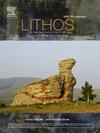Trans-crustal magmatic processes revealed by amphibole breakdown textures at the Quillacas monogenetic volcanic center, Bolivia
IF 2.9
2区 地球科学
Q2 GEOCHEMISTRY & GEOPHYSICS
引用次数: 0
Abstract
Amphibole exerts a fundamental control on arc magma petrogenesis, differentiation, and the long-term evolution of the arc crust. This study identifies two texturally distinct amphibole populations within andesitic lavas and entrained hornblendite cumulates at the Quillacas monogenetic volcanic center in the Eastern Altiplano, Bolivia. Within the hornblendites, all amphiboles are tschermakitic, large (≤800 μm) with thick, granular reaction rims (avg. 27 μm thickness). In the host andesites, tschermakites are also the dominant amphibole species but are smaller (250–400 μm) with thin, symplectic reaction rims (avg. 7–9 μm thickness). An intergrowth of symplectic and granular reaction rims is also observed in this population. The amphibole populations within the Quillacas magmatic system also record irregular volumetric decomposition where amphibole is replaced by mineral aggregates of plagioclase, pyroxene, and oxide within the crystal. This suggests the occurrence of a relatively slow reaction between the amphibole and melt trapped in fractures and cleavages during decompression-induced degassing. Geothermobarometry indicates that the hornblendite cumulate tschermakites crystallized at P-T conditions ranging from 467 to 598 ± 12 % MPa and 945–991 ± 22 °C. The host andesite tschermakites crystallized at P-T conditions ranging from 448 to 570 ± 12 % MPa and 928–1004 ± 22 °C. These geothermobarometric constraints correspond to depths of 16–24 km, which, within this region of the Central Andean crust, coincides with a regionally extensive low-seismic velocity zone. The texturally distinct amphibole populations imply that a multi-stage trans-crustal magmatic system is likely present beneath the Quillacas volcanic center. In this scenario, a crystal mush zone exists at upper crustal depths where the hornblendite cumulate tschermakites initially crystallized. Magma recharge into this mush zone initiated a reaction between hornblendite cumulates and the melt which formed the amphibole granular rims. This recharge event also transported the host andesite tschermakites that subsequently developed symplectic rims due to heating and ascent-driven decompression. This study supports the presence of amphibole-dominated mush filters in the upper crust of the Central Andean arc and advances our understanding of amphibole's role in the evolution of arc magmatic systems.
求助全文
约1分钟内获得全文
求助全文
来源期刊

Lithos
地学-地球化学与地球物理
CiteScore
6.80
自引率
11.40%
发文量
286
审稿时长
3.5 months
期刊介绍:
Lithos publishes original research papers on the petrology, geochemistry and petrogenesis of igneous and metamorphic rocks. Papers on mineralogy/mineral physics related to petrology and petrogenetic problems are also welcomed.
 求助内容:
求助内容: 应助结果提醒方式:
应助结果提醒方式:


